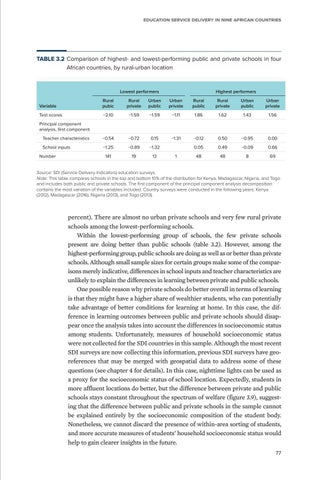Education service delivery in nine African countries
TABLE 3.2 Comparison of highest- and lowest-performing public and private schools in four African countries, by rural-urban location
Lowest performers
Highest performers
Variable
Rural pubic
Rural private
Urban public
Urban private
Rural public
Rural private
Urban public
Urban private
Test scores
−2.10
−1.59
−1.59
−1.11
1.86
1.62
1.43
1.56
Principal component analysis, first component Teacher characteristics
−0.54
−0.72
0.15
−1.31
−0.12
0.50
−0.95
0.00
School inputs
−1.25
−0.89
−1.32
0.05
0.49
−0.09
0.66
141
19
13
1
48
48
8
69
Number
Source: SDI (Service Delivery Indicators) education surveys. Note: This table compares schools in the top and bottom 10% of the distribution for Kenya, Madagascar, Nigeria, and Togo and includes both public and private schools. The first component of the principal component analysis decomposition contains the most variation of the variables included. Country surveys were conducted in the following years: Kenya (2012), Madagascar (2016), Nigeria (2013), and Togo (2013).
percent). There are almost no urban private schools and very few rural private schools among the lowest-performing schools. Within the lowest-performing group of schools, the few private schools present are doing better than public schools (table 3.2). However, among the highest-performing group, public schools are doing as well as or better than private schools. Although small sample sizes for certain groups make some of the comparisons merely indicative, differences in school inputs and teacher characteristics are unlikely to explain the differences in learning between private and public schools. One possible reason why private schools do better overall in terms of learning is that they might have a higher share of wealthier students, who can potentially take advantage of better conditions for learning at home. In this case, the difference in learning outcomes between public and private schools should disappear once the analysis takes into account the differences in socioeconomic status among students. Unfortunately, measures of household socioeconomic status were not collected for the SDI countries in this sample. Although the most recent SDI surveys are now collecting this information, previous SDI surveys have georeferences that may be merged with geospatial data to address some of these questions (see chapter 4 for details). In this case, nighttime lights can be used as a proxy for the socioeconomic status of school location. Expectedly, students in more affluent locations do better, but the difference between private and public schools stays constant throughout the spectrum of welfare (figure 3.9), suggesting that the difference between public and private schools in the sample cannot be explained entirely by the socioeconomic composition of the student body. Nonetheless, we cannot discard the presence of within-area sorting of students, and more accurate measures of students’ household socioeconomic status would help to gain clearer insights in the future. 77


